My night shift is going really well. I’ve spent the last couple of hours tying rigs with no disturbances; it’s been a quiet night. I have a DVD on in the background too and the kettle within reach. I like shifts like this, it’s hardly like working at all!
I’ve been running low on rigs with all the recent sessions and with a lack of 2/0 hooks in stock I ordered in a bunch of bits to tie some more. Winter time I’m fishing mostly with 4/0 running leger pennel rigs for the cod but with rays, smoothounds and a lot of dogfish in right now, plus a few bonus dabs, I’m using the smaller hooks again. So, a quick rundown of the bits and then I’ll get onto what I’ve been tying…

Hooks – Fladen Maxximus 2/0 Jig Hook. A chemically sharpened needle point barbed hook with a couple of barbs on the shank, this is designed for crab and soft baits. Thick gauge, it should keep its shape when unhooking which is a bit of an issue with the hard mouths found on these cartilaginous species. The wide gape is spot on for squid baits, keeping the hook point clear when pushed through the head at the bottom or the mantle at the top. I have some 4/0’s of the same pattern too and the shank barbs will help to keep worm baits in place too and the same rigs are being tied with these but that’s not for this time of year.
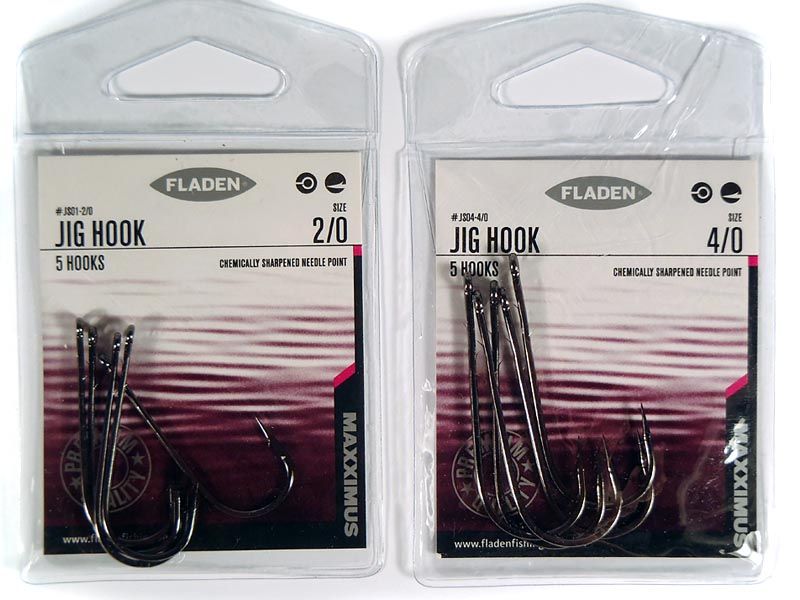
Swivels – Fladen Rolling Swivels, size 4. Tough swivels, stronger than the line I’m using, these don’t have spirals to trap line and a rounded eye at each end to not compress the knot either. Small enough to minimise the amount of weed they catch there’s more than enough space for them to rotate smoothly. A second version with a snap link attached is used for attaching leads on the bottom of my livebait trace or allowing a quick change of lures on an anti-tangle leader.
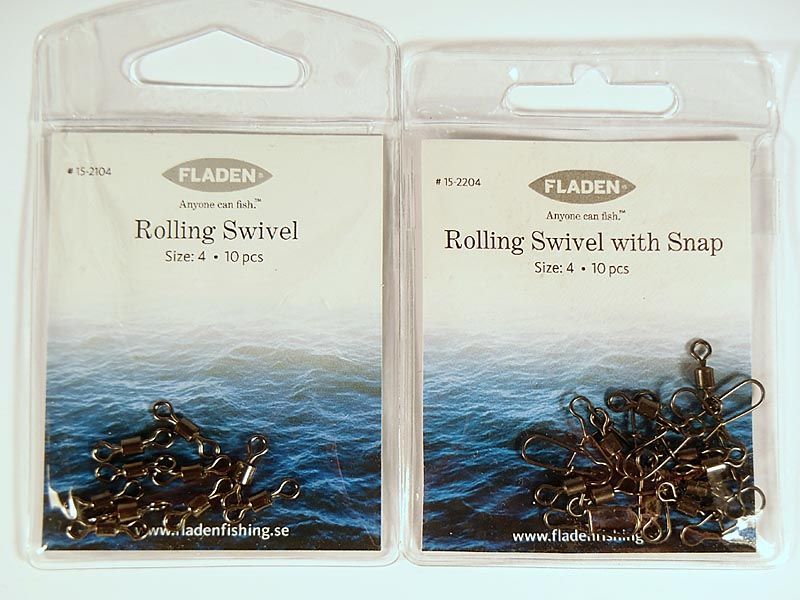
Beads – Fladen Luminous Beads, 6x10mm. Nice and wide, oval and with a large hole through the centre these run easily up and down the line, their main task being as knot protectors to avoid the swivels catching on them but also in use as spreaders on the wishbone. Being luminous there is also some attraction possibilities with them though this is of more use in areas that aren’t filled with suspended sand and mud such as we have here on the Suffolk coastline.
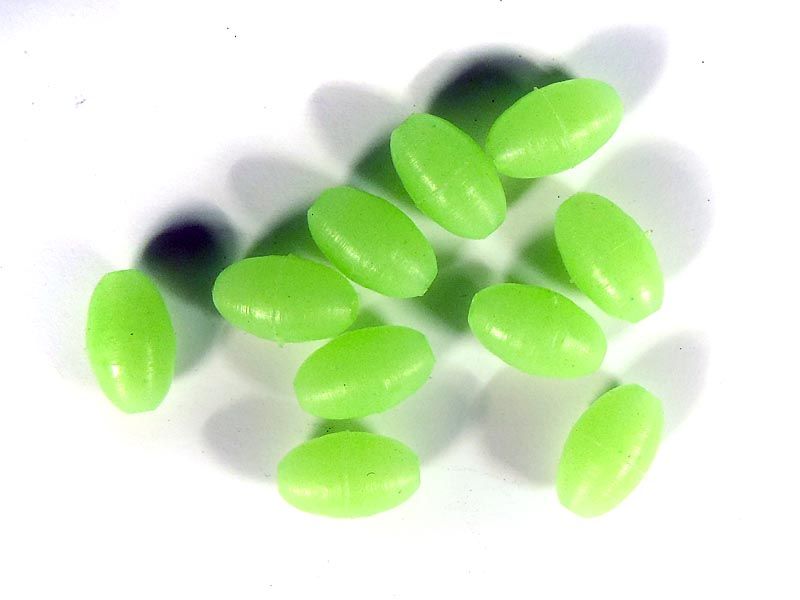
Sliding weight clip – Fladen Zip Slider. Red plastic with a large diameter hole through the centre to allow smooth running and a large wire clip to hold the sinker these form the basis of my main two rigs. Locked off at either end by a bead and swivel they form a stop against which a fish picking up the bait and moving downtide with it will often hook itself; it also allows a lead to be kept lower to the business end on casting while retaining a long trace.
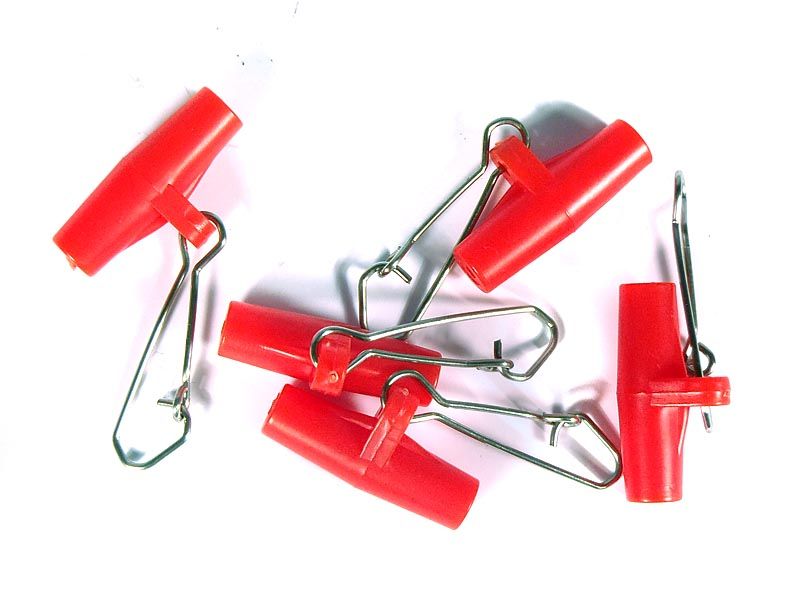
Crimps – Fladen 1.2mm Single Sleeves. Designed for 20-30lb line diameters these close down on the line and lock off the luminous beads to stop them from moving on the wishbone. Crimped centrally with the ends left untouched they shouldn’t damage the line.
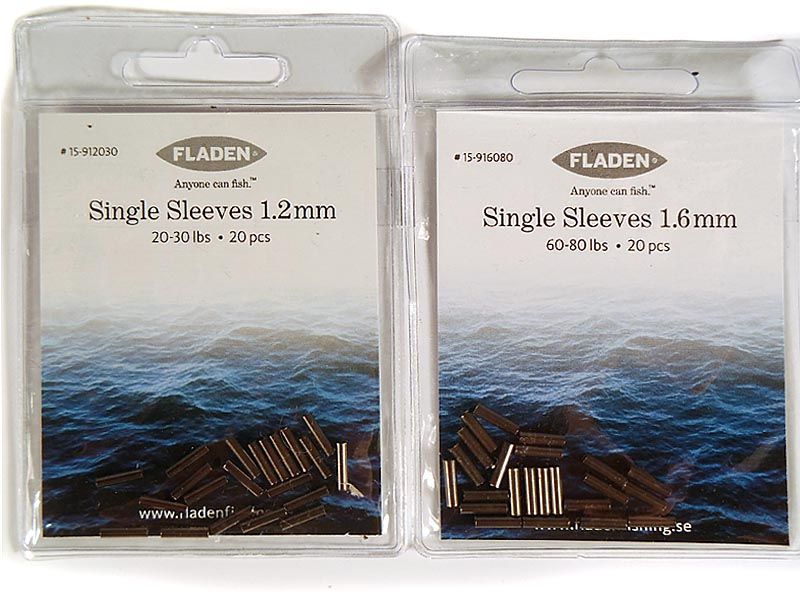
Sleeving – Fladen 1.5mm Silicone Rig Tube. Sold in one metre lengths, this is easily cut to size and slid over the shank of the upper hook on a pennel rig keeping it straight and allowing limited movement when wanted while holding position normally.
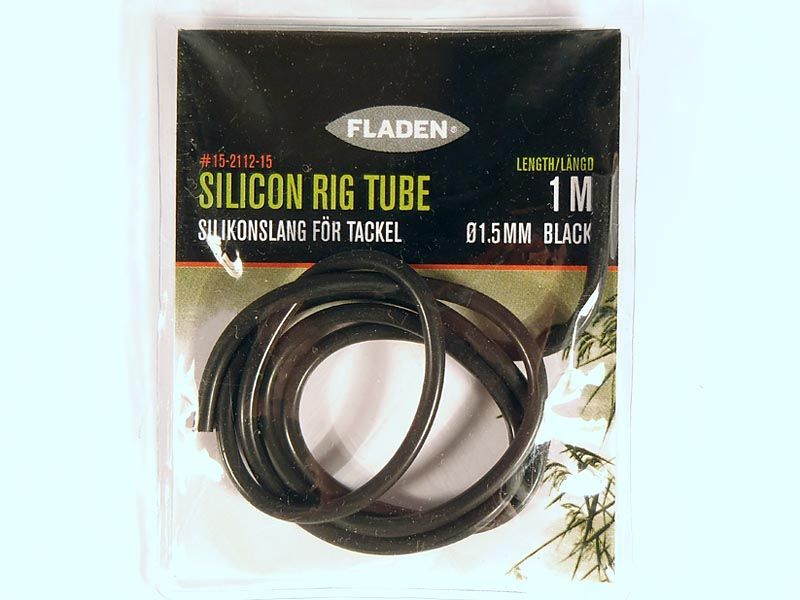
Line – Fladen Maxximus 21.3lb 0.38mm Fluorocarbon. Though the water clarity makes this pointless in terms of its invisibility, fluorocarbon has less stretch than standard monofilament line and thus gives a straighter, semi-rigid trace when stretched after uncoiling from the packet.
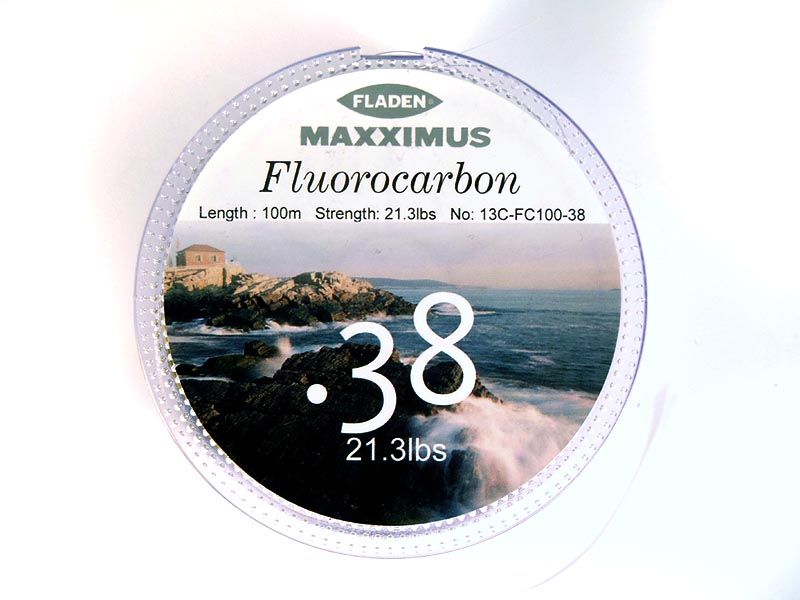
So, with the components covered it’s onto the traces. These have been tied shorter than normal and with black line to make them easier to photograph and subsequently use for copying.
Running Leger Link.
This is the basis of both the pennel and wishbone rigs. A swivel is tied to either end of 12 inches of line with a bead placed either side of a zip slider to stop the slider jamming on the knots which are covered with a piece of silicon tubing.
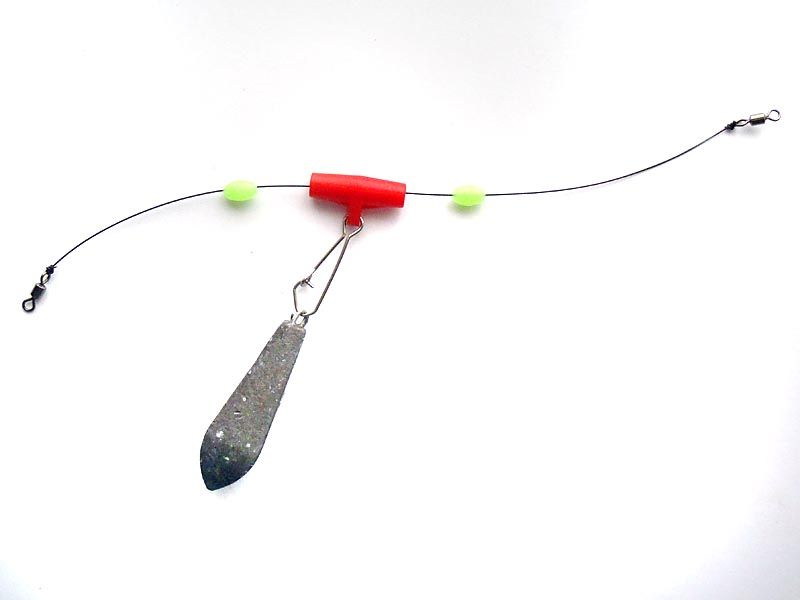
Flowing Pennel.
The standard trace when requiring a single bait to be held hard on the bottom. 36 inches of line tied to the running leger link at one end it terminates in a single hook. Further up the trace another hook is placed with the line running freely through it. A length of silicon tubing is then pulled down over both knots as well as the shank to keep it inline with the line wound a few times around the shank before exiting the eye; this allows the hooks to be moved to the correct position to hold a bait effectively, dependent on its size and the hook at either end allows a fish to be targeted no matter which end of the bait it grabs hold of first.

Spreader Wishbone.
For fishing two baits hard on the bottom. Again utilising the running leger link a further 12 inch length of line is tied to the swivel with another swivel at the end of it, all connections but the two central swivels having silicon over them. Through this, 24 inches of line is placed with a hook at either end. These are held in position at the same length from the swivel in the centre. Five beads are then placed either side of the swivel and held in place with a crimp with the line stretched tight; this produces a semi-rigid spreader bar that keeps two baits apart on the bottom next to each other, increasing the scent while giving a smaller mouthful, easier to swallow in one go with the added possibility of a double shot.
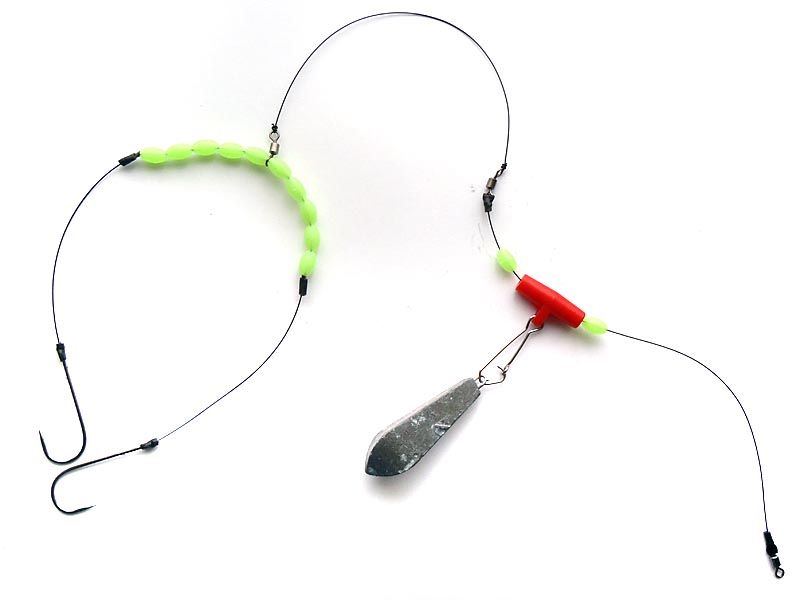
Livebait Rig.
While a running leger pennel rig is effective for bottom feeders it is sometimes worth lifting the bait fish off the bottom where it becomes more visible and is less likely to damage the line through abrasion. The bottom of the trace is a swivel with snap link to hold the sinker. 12 inches of line runs up to another swivel. 36 inches of line is tied to this with another swivel at the top. On the longer length, a bead is placed either side of a swivel that can run freely along its length. To this 24 inches of line is tied, terminating in a single 4/0 hook, all connections covered in silicon tubing. A baitfish, hooked through the lip, can be fished straight down and can swim around in a 4ft circle without tangling the mainline.

That's the rigs; I can tie many different ones which all have their specific uses but I never use them, even the bog standard 2 or 3 hook flapper rig (I'd rather use baited feathers or hokkais). As to knots I only use one, shown to me over twenty years ago and I’ve never found any better. Known as the Centauri Knot, when done correctly this retains line strength (when lubricated with spit during the tightening proves of course) and provides a compact knot that doesn’t give. Begin by threading the line through the hook/swivel then return parallel to the mainline. Pinch the line over the eye then form three loops with the tag end around the mainline before going through the back of the three loops and pulling taut away from the eye.
Wire Pike Traces.
There are two traces to consider here, one for baits, live or dead, and one for lures. Both utilise 12 inches of wire, in this instance Fladen 26lb nylon coated trace wire (the nylon reduces kinks) with Size 4 rolling swivels, the same swivels with snap links, 1.5mm Silicone Tubing and 1.6mm Single Sleeve crimps. Hooks on the bait trace are Fladen Trebles, Size 2. The idea is that these large hooks catch hold before they travel too far down the throat thus making removal easier.
Bait Trace
Cut 12 inches of wire and loop the end around a swivel, feeding the tag end back towards the main trace and into a crimp, ensuring that the end does not protrude as this can catch line and fingers and then cover with a short piece of silicon. Then, feed a length of tubing up from the other end followed by the first treble and another length of tubing. At the free end form a loop around the eye of your bottom treble hook and close with a crimp as before. Cover the shank of the bottom treble with tube then pull the floating treble into place and cover that shank with tube as well to hold it in place, movable when necessary be it to suit the bait or to ease removal from a captured pike.
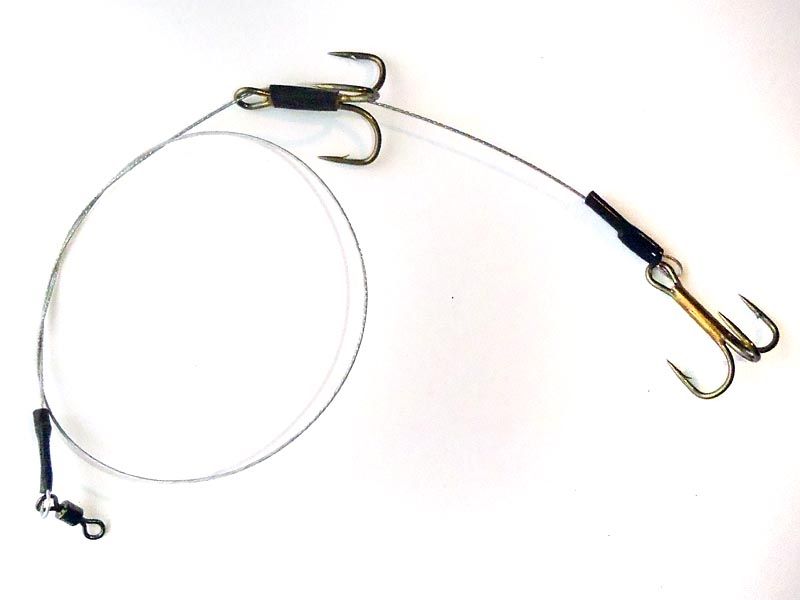
Lure Trace.
A simple wire trace for lure fishing that allows a quick change. Loop either end of 12 inches of trace wire into a crimp with one end around a swivel, the other around a swivel with snap link. Cover the crimps with silicon tubing and ensure no tag ends are protruding to catch weed or unwary fingers.
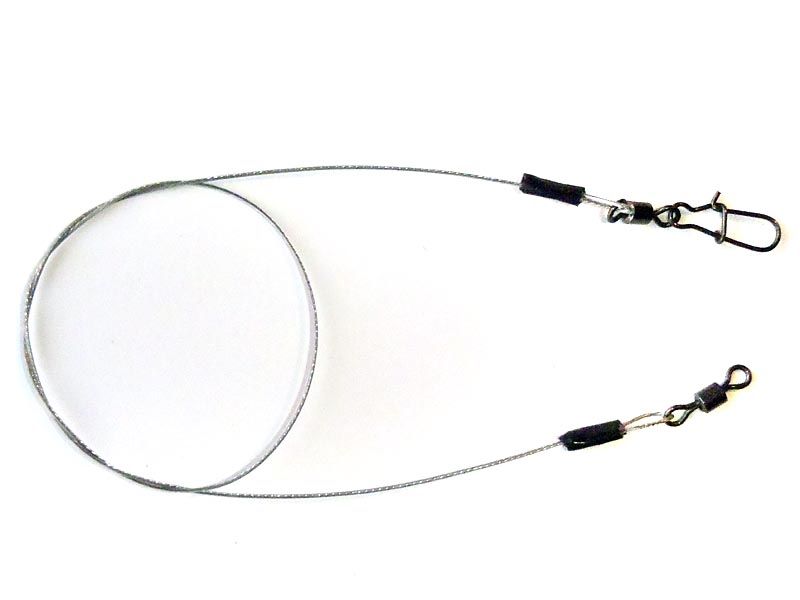
Any trace that becomes kinked in use needs to be replaced as it will be dramatically weakened and can snap under the slightest tension. With ten metres of wire on a spool it shouldn’t be a problem.
 Hooks – Fladen Maxximus 2/0 Jig Hook. A chemically sharpened needle point barbed hook with a couple of barbs on the shank, this is designed for crab and soft baits. Thick gauge, it should keep its shape when unhooking which is a bit of an issue with the hard mouths found on these cartilaginous species. The wide gape is spot on for squid baits, keeping the hook point clear when pushed through the head at the bottom or the mantle at the top. I have some 4/0’s of the same pattern too and the shank barbs will help to keep worm baits in place too and the same rigs are being tied with these but that’s not for this time of year.
Hooks – Fladen Maxximus 2/0 Jig Hook. A chemically sharpened needle point barbed hook with a couple of barbs on the shank, this is designed for crab and soft baits. Thick gauge, it should keep its shape when unhooking which is a bit of an issue with the hard mouths found on these cartilaginous species. The wide gape is spot on for squid baits, keeping the hook point clear when pushed through the head at the bottom or the mantle at the top. I have some 4/0’s of the same pattern too and the shank barbs will help to keep worm baits in place too and the same rigs are being tied with these but that’s not for this time of year.
 Swivels – Fladen Rolling Swivels, size 4. Tough swivels, stronger than the line I’m using, these don’t have spirals to trap line and a rounded eye at each end to not compress the knot either. Small enough to minimise the amount of weed they catch there’s more than enough space for them to rotate smoothly. A second version with a snap link attached is used for attaching leads on the bottom of my livebait trace or allowing a quick change of lures on an anti-tangle leader.
Swivels – Fladen Rolling Swivels, size 4. Tough swivels, stronger than the line I’m using, these don’t have spirals to trap line and a rounded eye at each end to not compress the knot either. Small enough to minimise the amount of weed they catch there’s more than enough space for them to rotate smoothly. A second version with a snap link attached is used for attaching leads on the bottom of my livebait trace or allowing a quick change of lures on an anti-tangle leader.
 Beads – Fladen Luminous Beads, 6x10mm. Nice and wide, oval and with a large hole through the centre these run easily up and down the line, their main task being as knot protectors to avoid the swivels catching on them but also in use as spreaders on the wishbone. Being luminous there is also some attraction possibilities with them though this is of more use in areas that aren’t filled with suspended sand and mud such as we have here on the Suffolk coastline.
Beads – Fladen Luminous Beads, 6x10mm. Nice and wide, oval and with a large hole through the centre these run easily up and down the line, their main task being as knot protectors to avoid the swivels catching on them but also in use as spreaders on the wishbone. Being luminous there is also some attraction possibilities with them though this is of more use in areas that aren’t filled with suspended sand and mud such as we have here on the Suffolk coastline.
 Sliding weight clip – Fladen Zip Slider. Red plastic with a large diameter hole through the centre to allow smooth running and a large wire clip to hold the sinker these form the basis of my main two rigs. Locked off at either end by a bead and swivel they form a stop against which a fish picking up the bait and moving downtide with it will often hook itself; it also allows a lead to be kept lower to the business end on casting while retaining a long trace.
Sliding weight clip – Fladen Zip Slider. Red plastic with a large diameter hole through the centre to allow smooth running and a large wire clip to hold the sinker these form the basis of my main two rigs. Locked off at either end by a bead and swivel they form a stop against which a fish picking up the bait and moving downtide with it will often hook itself; it also allows a lead to be kept lower to the business end on casting while retaining a long trace.
 Crimps – Fladen 1.2mm Single Sleeves. Designed for 20-30lb line diameters these close down on the line and lock off the luminous beads to stop them from moving on the wishbone. Crimped centrally with the ends left untouched they shouldn’t damage the line.
Crimps – Fladen 1.2mm Single Sleeves. Designed for 20-30lb line diameters these close down on the line and lock off the luminous beads to stop them from moving on the wishbone. Crimped centrally with the ends left untouched they shouldn’t damage the line.
 Sleeving – Fladen 1.5mm Silicone Rig Tube. Sold in one metre lengths, this is easily cut to size and slid over the shank of the upper hook on a pennel rig keeping it straight and allowing limited movement when wanted while holding position normally.
Sleeving – Fladen 1.5mm Silicone Rig Tube. Sold in one metre lengths, this is easily cut to size and slid over the shank of the upper hook on a pennel rig keeping it straight and allowing limited movement when wanted while holding position normally.
 Line – Fladen Maxximus 21.3lb 0.38mm Fluorocarbon. Though the water clarity makes this pointless in terms of its invisibility, fluorocarbon has less stretch than standard monofilament line and thus gives a straighter, semi-rigid trace when stretched after uncoiling from the packet.
Line – Fladen Maxximus 21.3lb 0.38mm Fluorocarbon. Though the water clarity makes this pointless in terms of its invisibility, fluorocarbon has less stretch than standard monofilament line and thus gives a straighter, semi-rigid trace when stretched after uncoiling from the packet.
 So, with the components covered it’s onto the traces. These have been tied shorter than normal and with black line to make them easier to photograph and subsequently use for copying.
Running Leger Link.
This is the basis of both the pennel and wishbone rigs. A swivel is tied to either end of 12 inches of line with a bead placed either side of a zip slider to stop the slider jamming on the knots which are covered with a piece of silicon tubing.
So, with the components covered it’s onto the traces. These have been tied shorter than normal and with black line to make them easier to photograph and subsequently use for copying.
Running Leger Link.
This is the basis of both the pennel and wishbone rigs. A swivel is tied to either end of 12 inches of line with a bead placed either side of a zip slider to stop the slider jamming on the knots which are covered with a piece of silicon tubing.
 Flowing Pennel.
The standard trace when requiring a single bait to be held hard on the bottom. 36 inches of line tied to the running leger link at one end it terminates in a single hook. Further up the trace another hook is placed with the line running freely through it. A length of silicon tubing is then pulled down over both knots as well as the shank to keep it inline with the line wound a few times around the shank before exiting the eye; this allows the hooks to be moved to the correct position to hold a bait effectively, dependent on its size and the hook at either end allows a fish to be targeted no matter which end of the bait it grabs hold of first.
Flowing Pennel.
The standard trace when requiring a single bait to be held hard on the bottom. 36 inches of line tied to the running leger link at one end it terminates in a single hook. Further up the trace another hook is placed with the line running freely through it. A length of silicon tubing is then pulled down over both knots as well as the shank to keep it inline with the line wound a few times around the shank before exiting the eye; this allows the hooks to be moved to the correct position to hold a bait effectively, dependent on its size and the hook at either end allows a fish to be targeted no matter which end of the bait it grabs hold of first.
 Spreader Wishbone.
For fishing two baits hard on the bottom. Again utilising the running leger link a further 12 inch length of line is tied to the swivel with another swivel at the end of it, all connections but the two central swivels having silicon over them. Through this, 24 inches of line is placed with a hook at either end. These are held in position at the same length from the swivel in the centre. Five beads are then placed either side of the swivel and held in place with a crimp with the line stretched tight; this produces a semi-rigid spreader bar that keeps two baits apart on the bottom next to each other, increasing the scent while giving a smaller mouthful, easier to swallow in one go with the added possibility of a double shot.
Spreader Wishbone.
For fishing two baits hard on the bottom. Again utilising the running leger link a further 12 inch length of line is tied to the swivel with another swivel at the end of it, all connections but the two central swivels having silicon over them. Through this, 24 inches of line is placed with a hook at either end. These are held in position at the same length from the swivel in the centre. Five beads are then placed either side of the swivel and held in place with a crimp with the line stretched tight; this produces a semi-rigid spreader bar that keeps two baits apart on the bottom next to each other, increasing the scent while giving a smaller mouthful, easier to swallow in one go with the added possibility of a double shot.
 Livebait Rig.
While a running leger pennel rig is effective for bottom feeders it is sometimes worth lifting the bait fish off the bottom where it becomes more visible and is less likely to damage the line through abrasion. The bottom of the trace is a swivel with snap link to hold the sinker. 12 inches of line runs up to another swivel. 36 inches of line is tied to this with another swivel at the top. On the longer length, a bead is placed either side of a swivel that can run freely along its length. To this 24 inches of line is tied, terminating in a single 4/0 hook, all connections covered in silicon tubing. A baitfish, hooked through the lip, can be fished straight down and can swim around in a 4ft circle without tangling the mainline.
Livebait Rig.
While a running leger pennel rig is effective for bottom feeders it is sometimes worth lifting the bait fish off the bottom where it becomes more visible and is less likely to damage the line through abrasion. The bottom of the trace is a swivel with snap link to hold the sinker. 12 inches of line runs up to another swivel. 36 inches of line is tied to this with another swivel at the top. On the longer length, a bead is placed either side of a swivel that can run freely along its length. To this 24 inches of line is tied, terminating in a single 4/0 hook, all connections covered in silicon tubing. A baitfish, hooked through the lip, can be fished straight down and can swim around in a 4ft circle without tangling the mainline.
 That's the rigs; I can tie many different ones which all have their specific uses but I never use them, even the bog standard 2 or 3 hook flapper rig (I'd rather use baited feathers or hokkais). As to knots I only use one, shown to me over twenty years ago and I’ve never found any better. Known as the Centauri Knot, when done correctly this retains line strength (when lubricated with spit during the tightening proves of course) and provides a compact knot that doesn’t give. Begin by threading the line through the hook/swivel then return parallel to the mainline. Pinch the line over the eye then form three loops with the tag end around the mainline before going through the back of the three loops and pulling taut away from the eye.
Wire Pike Traces.
There are two traces to consider here, one for baits, live or dead, and one for lures. Both utilise 12 inches of wire, in this instance Fladen 26lb nylon coated trace wire (the nylon reduces kinks) with Size 4 rolling swivels, the same swivels with snap links, 1.5mm Silicone Tubing and 1.6mm Single Sleeve crimps. Hooks on the bait trace are Fladen Trebles, Size 2. The idea is that these large hooks catch hold before they travel too far down the throat thus making removal easier.
Bait Trace
Cut 12 inches of wire and loop the end around a swivel, feeding the tag end back towards the main trace and into a crimp, ensuring that the end does not protrude as this can catch line and fingers and then cover with a short piece of silicon. Then, feed a length of tubing up from the other end followed by the first treble and another length of tubing. At the free end form a loop around the eye of your bottom treble hook and close with a crimp as before. Cover the shank of the bottom treble with tube then pull the floating treble into place and cover that shank with tube as well to hold it in place, movable when necessary be it to suit the bait or to ease removal from a captured pike.
That's the rigs; I can tie many different ones which all have their specific uses but I never use them, even the bog standard 2 or 3 hook flapper rig (I'd rather use baited feathers or hokkais). As to knots I only use one, shown to me over twenty years ago and I’ve never found any better. Known as the Centauri Knot, when done correctly this retains line strength (when lubricated with spit during the tightening proves of course) and provides a compact knot that doesn’t give. Begin by threading the line through the hook/swivel then return parallel to the mainline. Pinch the line over the eye then form three loops with the tag end around the mainline before going through the back of the three loops and pulling taut away from the eye.
Wire Pike Traces.
There are two traces to consider here, one for baits, live or dead, and one for lures. Both utilise 12 inches of wire, in this instance Fladen 26lb nylon coated trace wire (the nylon reduces kinks) with Size 4 rolling swivels, the same swivels with snap links, 1.5mm Silicone Tubing and 1.6mm Single Sleeve crimps. Hooks on the bait trace are Fladen Trebles, Size 2. The idea is that these large hooks catch hold before they travel too far down the throat thus making removal easier.
Bait Trace
Cut 12 inches of wire and loop the end around a swivel, feeding the tag end back towards the main trace and into a crimp, ensuring that the end does not protrude as this can catch line and fingers and then cover with a short piece of silicon. Then, feed a length of tubing up from the other end followed by the first treble and another length of tubing. At the free end form a loop around the eye of your bottom treble hook and close with a crimp as before. Cover the shank of the bottom treble with tube then pull the floating treble into place and cover that shank with tube as well to hold it in place, movable when necessary be it to suit the bait or to ease removal from a captured pike.
 Lure Trace.
A simple wire trace for lure fishing that allows a quick change. Loop either end of 12 inches of trace wire into a crimp with one end around a swivel, the other around a swivel with snap link. Cover the crimps with silicon tubing and ensure no tag ends are protruding to catch weed or unwary fingers.
Lure Trace.
A simple wire trace for lure fishing that allows a quick change. Loop either end of 12 inches of trace wire into a crimp with one end around a swivel, the other around a swivel with snap link. Cover the crimps with silicon tubing and ensure no tag ends are protruding to catch weed or unwary fingers.
 Any trace that becomes kinked in use needs to be replaced as it will be dramatically weakened and can snap under the slightest tension. With ten metres of wire on a spool it shouldn’t be a problem.
Any trace that becomes kinked in use needs to be replaced as it will be dramatically weakened and can snap under the slightest tension. With ten metres of wire on a spool it shouldn’t be a problem.
No comments:
Post a Comment